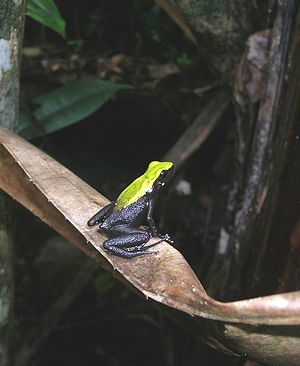Mantella laevigata
| Mantella laevigata | ||||||||||||
|---|---|---|---|---|---|---|---|---|---|---|---|---|

Mantella laevigata |
||||||||||||
| Systematics | ||||||||||||
|
||||||||||||
| Scientific name | ||||||||||||
| Mantella laevigata | ||||||||||||
| Methuen & Hewitt , 1913 |
Mantella laevigata is a species from the genus Madagascar colored frogs ( Mantella ) that is endemic to Madagascar .
description
Mantella laevigata , with a body length of 22 to 29 mm, is one of the medium-sized representatives of its genus. The frog is slim; the ends of his toes and fingertips are significantly enlarged. The animals are dorsally colored from the tip of the snout to the rear middle part of the back, lemon yellow, the rest of the body is black. The yellow colored area on the back has a clear border to the black flanks and to the side of the head. The limbs are jet black, often with blue dots on the hands and fingertips. The colored frog has no red, orange or yellow pattern on its hind legs; nor does it have a light stripe above the sides of the snout. However, some specimens have individual yellow spots under the eyes. The underside and legs are colored black and have small, round, bluish or bluish-gray spots. The throat is usually completely black in color.
Occurrence, way of life
The species lives endemically in the north-eastern coastal region of Madagascar, including on the Masoala peninsula and the offshore island of Nosy Mangabe . The animals inhabit the rainforest floor and feed primarily on ants and termites.
Reproduction and Individual Development
Mating calls by the males - series of short double-click sounds - are only uttered during the day. To lay their eggs, the frogs climb trees up to a height of almost four meters. The female lays its individual, quite large, white eggs one to two centimeters above the water surface of water-filled tree hollows or knots of bamboo. Embryonic development can be seen two days later. The hatching tadpoles eventually fall into the water holes. Within these water points there is only a single larva or two in different stages of development. The tadpoles are omnivores, but their mother prefers to feed them with unfertilized eggs.
Web links
- Species portrait at www.amphibiaweb.org (Engl.)
- Mantella laevigata in the endangered Red List species the IUCN 2004. Posted by: Franco Andreone, Frank Glaw, 2004. Accessed March 12, 2012th
